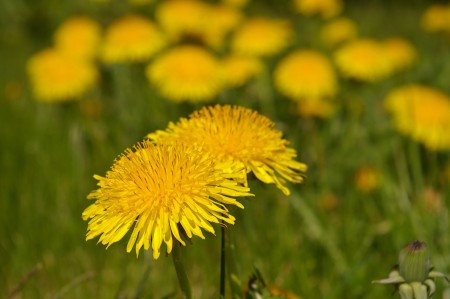
If the grass is always greener on the other side of your fence, Prof. Katerina Serlemitsos Jordan can help you make your neighbours green with envy with a healthy lawn.
An avid golfer, she decided to pursue a PhD in turf pathology and now works with golf courses, athletic fields and sod farms to diagnose and treat lawn problems.
Weeds are among the biggest enemies of a healthy lawn, taking advantage of weaknesses such as poor soil and lack of nutrients. Lawns face a constant barrage of weed seeds from the air – one dandelion can produce more than 2,000 parachute-equipped seeds per year. Whether the seeds germinate or not depends on the health of the lawn.
The same conditions that are bad for grass are ideal for weeds: lack of fertilizer, aeration and water. “When you don’t give it everything it needs, it starts to weaken,” she says. “I would say 80 to 90 per cent of the time that we see a really weedy lawn, it’s because that lawn hasn’t been looked after.”
Nitrogen is key to a healthy lawn, so choose a fertilizer that contains this nutrient.
But fertilizer alone won’t help a lawn that is more than half weeds. That’s when a lawn needs intensive care. Serlemitsos Jordan recommends removing as many weeds as possible by hand and filling each hole with topsoil, grass seeds and fertilizer to prevent weeds from returning. “You don’t need to remove 100 per cent of them. Even if you get to half of them, it gives your grass a fighting chance.”
She admits that not everyone has the time or patience to get down on their hands and knees and pluck weeds. For those who prefer chemical warfare, she recommends hiring a lawn care company to apply an approved herbicide. “Some weeds are really difficult,” she says. “Dandelions are tough because they have a really long taproot.” Removing a dandelion above ground often leaves the root behind, which can grow into a new plant.
But not all weeds are bad. Clover, for example, is a good ground cover for bare patches. “If you see a lot of clover in your lawn, it’s usually an indicator that your nitrogen is low,” says Serlemitsos Jordan. “The nice thing about clover is that it doesn’t need nitrogen because it’s a legume.” These types of plants have bacteria in their roots that allow them to use nitrogen in the air. Clover is ideal for low-traffic areas, but she cautions against growing it where children play because the flowers attract bees.
Choosing a low-maintenance grass species can also help win the weed war. Most lawns contain Kentucky bluegrass, which needs a lot of sunlight and nitrogen. In drought conditions, the grass turns brown and becomes dormant until the next rainfall. If you want to keep your lawn green for most of the summer, choose fescue, which is more shade- and drought-tolerant and doesn’t need much nitrogen.
Another common mistake that homeowners make is letting their lawn grow too long and then cutting it too short. Removing more than one third of the grass blade stresses the plant, so mow more often and cut off less. Make sure your blades are sharp because a clean cut heals better and retains more moisture.
“It’s so simple,” she says of lawn care. “If you feed it, if you water it and if you take care of the soil beneath it, it’ll work out beautifully.” These steps will help make your lawn healthier, but she adds that insects pose another set of challenges.
1. Feed your lawn with a slow-release fertilizer with nitrogen.
2. Aerate your lawn in the fall to reduce compaction and allow oxygen into the soil.
3. Plant hardier grass species like fescue.